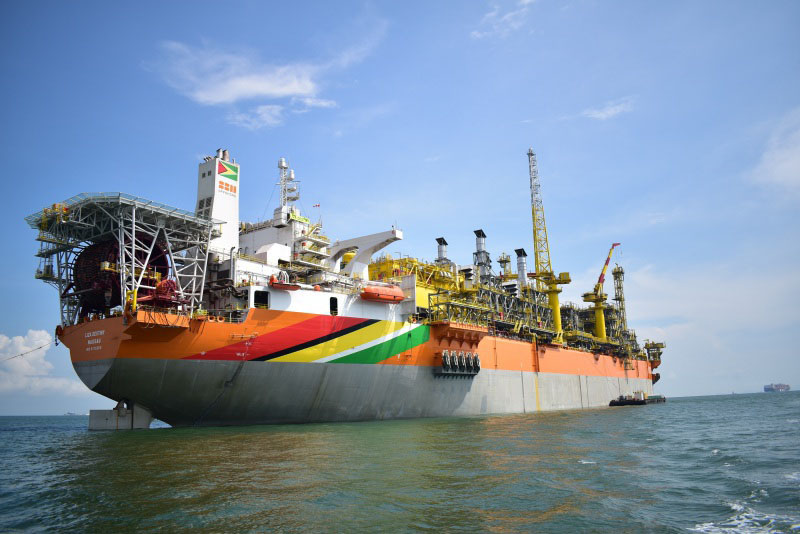With a massive $20.8b earmarked for the planned gas to energy project, the historic tapping of US$607.6m in oil revenues is the major financier of the 2022 budget and the government is projecting a further US$957.6m in petroleum revenues this year.
Minister of Finance, Dr. Ashni Singh yesterday said that of the $552.9b Budget, the US$607.6m and the US$54m balance received from Norway under the GRIF facility contribute more than half of this year’s budget at $301.3 billion.
From that amount, he explained that $20.8b will be set aside for the gas-to-energy project “Major allocations within this [the 303.3b] amount include: $20.8b for the gas-to-energy project and $1.4 billion for the 33 MWs solar farms for Berbice, Essequibo, and Linden,” he said in his budget presentation yesterday at the Arthur Chung Conference Centre.
Pointing out that the current estimate of the gas reserve offshore is pegged at some 16 trillion cubic feet (tcf) with projections from the Liza 1 and Liza 2 wells likely at 50 million standard cubic feet per day (mmscfd) and the Payara well bringing in an additional 20 mmscfd, he contended that it “augurs extremely well for the gas-to-energy project”.
“This project will allow us to phase out the use of expensive and carbon-intensive heavy fuel oil and is targeted to reduce costs substantially below the current levels. This project encompasses the establishment of a power plant to generate 300 MW of power as well as a Natural Gas Liquids (NGL) plant that will cover domestic demand. The project also entails the construction of a 225km 12” pipeline to transport the guaranteed minimum of 50 mmcfd of natural gas from offshore Guyana to the Wales Development Authority,” he said.
For the first time, government announced yesterday that “ongoing geotechnical and geophysical works for both offshore and onshore operations are advancing with portions already completed.”
Singh said that, “An Environmental and Social Impact Assessment is expected to be completed by early second quarter of 2022. Utilising a transparent procurement process it is expected that the firm selected would be able to engineer, procure and construct the Power Plant and NGL Plant along with related facilities. Construction is expected to start in the third quarter of 2022 and will be completed by the fourth quarter of 2024. “
He defended the project and said that it was the Irfaan Ali-led government’s aim to advance this country’s transition to cleaner sources of energy, “while ensuring that we meet the growing demand for electricity and reduce the cost of electricity by 50 percent over the next 5 years.”
Ports
The Finance Minister also noted that as government expects major development on both sides of the Demerara River, private investments are being encouraged to develop port facilities at the mouth of this country’s main rivers.
“To this end, two new oil and gas shore base facilities are expected to be constructed by private investors on the western side of the Demerara River. Additionally, at the mouth of the Berbice River, work has already commenced by private investors to construct a port facility also to service our oil and gas industry,” he said.
Giving an overview of the oil and gas sector and proposed plans for its development as Guyana forges ahead with offshore production and continued exploration, Singh pointed out that from the commencement of oil production in December 2019 to the end of 2021, there were 69 lifts of oil exported from Guyana, of which only nine were for Government.
In March 2020, according to Singh, US$54.9 million from the nation’s first lift of crude oil was deposited into the Fund, followed by the first royalty payment of US$4.9 million at the end of April 2020. The Fund received US$185.4 million from four lifts of profit oil and US$12.9 million from royalties for the period March 2020 to December 2020.
“In 2021, the Fund received US$357.2 million from Government’s share of profit oil, and US$52 million from royalties, and at the end of the year, the Fund’s cumulative balance stood at US$607.6 million,” he said.
As a new oil and gas producer and with this country having the 17th largest oil reserves in the world to date, the Finance Minister posited that “the oil and gas sector promises to be the driver of historically high levels of growth in the Guyanese economy with strong positive spillovers into the non-oil economy.”
“This is already observed in our economic performance over the past two years, and the external environment remains supportive with demand for oil anticipated to exceed pre-pandemic levels in 2022 and a very positive near-term outlook,” he added.
Singh said that with 28 commercially viable oil discoveries to date in the Stabroek Block and an estimated recoverable resource of over 10 billion oil-equivalent barrels, 6 years after first discovery, the country is poised for world class development which his government will ensure.
He pointed out that the Stabroek Block currently has three identified production areas in Liza 1, Liza 2 and Payara and the current production capacity is 120,000 bpd, with the Liza Destiny Floating, Production, Storage and Offloading (FPSO) platform in operation.
He, however, gave no clear date of when the second FPSO – Liza Unity – will come into operation, only saying that it will be early in 2022 and that it will raise production capacity here to 340,000 bpd.
With the deployment of the Liza Prosperity FPSO in 2024, a further rise in capacity to 560,000 bpd, is expected and when Yellowtail comes on stream, somewhere around 2026 and 2027, production is poised to reach 810,000 bpd and could see Guyana reaching 6 FPSOs producing 1 million bpd by 2030.
Marketable approach
Exploration in the Kaieteur and Canje Blocks continues, Singh said, and can see additional wells coming online in the last quarter of 2022 if exploration is successful.
In addition, exploration activities will continue in the Kanuku Block.
And with lucrative deep sea areas still in hand, he reiterated that in the third quarter of this year, Government will be holding auctions and bidding rounds for those available acreages.
“This will be done in an open and competitive manner which will allow for a more marketable approach to Guyana’s resource development and at same time bring financial gains for the country,” he emphasized.
Turning attention to the Natural Resource Fund Act, Singh said that it was passed to ensure sound management of the revenues from the oil and gas sector. “Despite the many shortcomings of the 2019 Act, Government decided to focus attention in the immediate term on addressing the most egregious deficiencies. These included: fundamental weaknesses in the governance arrangements, including a high concentration of powers and responsibilities in the hands of the Minister of Finance, and the complete absence of a Board of Directors or similar governing body, as required by the Santiago Principles; lack of transparency, including an opaque and unnecessarily complicated formula for determining the ceiling on withdrawals from the Fund, and which was open to manipulation by the Minister of Finance; and loose arrangements that allowed for expenditure to be met directly from the Fund, bypassing the appropriation process, and therefore without prior parliamentary approval,” he said.
“The new NRF Act remedies these fundamental deficiencies by: scaling back the excessive powers of the Minister of Finance and removing any possibility of ministerial discretion in determining the ceiling on withdrawals; establishing a Board of Directors for the first time, and vesting in that Board the powers that were previously concentrated in the hands of the Minister; removing the possibility of any expenditure from the Fund being met without prior parliamentary approval; and strengthening transparency by requiring publication and parliamentary tabling of notification of every receipt into the Fund. These amendments constitute major improvements to the framework for managing the revenues from the sector,” he added.
Singh stated that “With two FPSO vessels expected to be in operation this year, it is anticipated that there will be 94 lifts from the Stabroek Block, 13 of which will be Government lifts. From this, it is estimated that deposits into the NRF for 2022 will total US$957.6 million, comprising some US$857.1 million earned from the Government lifts of profit oil, and an additional US$100.5 million from royalties”.










